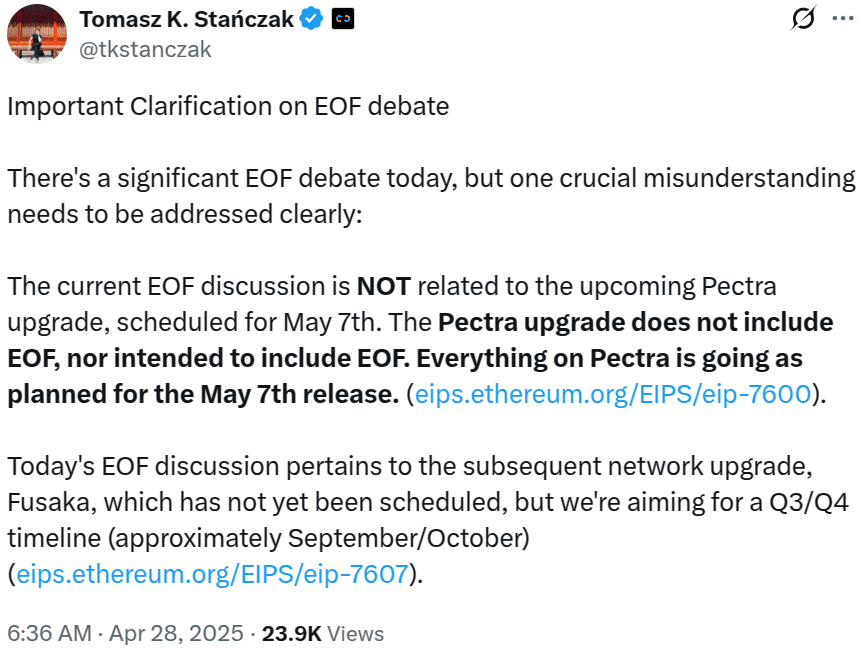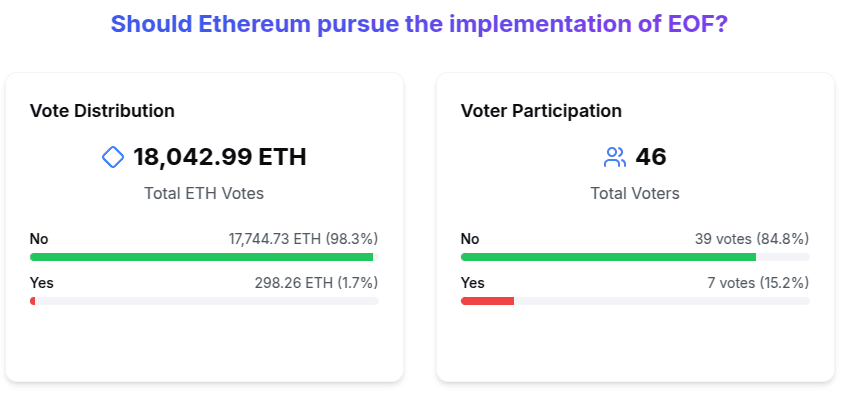Ethereum’s highly anticipated Fusaka hard fork is currently targeted for release in the third or fourth quarter of 2025, according to an Ethereum Foundation official. This upgrade marks a significant evolution of the Ethereum Virtual Machine (EVM) and will likely introduce the EVM Object Format (EOF).
The implementation of EOF aims to enhance the efficiency, security, and upgradability of smart contracts on the Ethereum network. However, its introduction has also sparked debate within the Ethereum community, with some developers raising concerns about increased complexity and potential vulnerabilities.
What is the Fusaka Hard Fork?
A hard fork is a major software upgrade that introduces a change to the protocol that is not backward-compatible. This requires all nodes on the network to upgrade to the new version to continue participating in the network. The Fusaka hard fork is planned to include the EVM Object Format (EOF) upgrade.
Understanding the EVM Object Format (EOF)
The EVM Object Format (EOF) is a set of Ethereum Improvement Proposals (EIPs) designed to improve the structure and execution of smart contracts within the Ethereum Virtual Machine (EVM). At its core, EOF seeks to replace the current free-form bytecode structure with a well-defined container format for smart contract bytecode.
Key Features of EOF:
- Container Module: EOF defines a container module for smart contract bytecode, structuring it for better organization and efficiency.
- Header: Each object begins with a header (0xEF00) and a version number, ensuring upgradability.
- Section Table: Provides metadata about the contents, improving transparency and verification.
- Sections: Separates code and data into distinct sections, optimizing EVM operation.
Benefits of the EOF Upgrade
The proposed benefits of the EOF upgrade are substantial:
- Enhanced Efficiency: By separating code and data, EOF streamlines EVM operation, leading to reduced processing overhead.
- Improved Security: EOF introduces stricter validation rules, minimizing the risk of vulnerabilities and malicious code injection.
- Simplified Development: The structured format of EOF improves the developer experience, making smart contracts easier to understand and maintain.
- Future-Proofing: The versioned container format ensures the EVM can evolve and adapt to future technological advancements.

The Controversy Surrounding EOF
Despite its potential benefits, the EOF upgrade has faced criticism from some members of the Ethereum community. The main concerns revolve around:
- Increased Complexity: Detractors argue that EOF adds unnecessary complexity to the EVM, making it more challenging for developers to work with.
- Tooling Upgrades: EOF requires significant tooling upgrades, potentially introducing new vulnerabilities and increasing the attack surface.
- Maintenance Overhead: Maintaining both the new EOF-enabled EVM and the legacy EVM could create additional overhead for developers and node operators.
EIP-4200 and Enhanced Security Measures
EIP-4200, a component of the EOF upgrade, addresses security concerns by providing an alternative to the traditional JUMP and JUMPI instructions. These instructions allow programs to jump to arbitrary memory locations, which can be exploited by attackers to inject malicious code. EIP-4200 introduces RJUMP and RJUMPI, which require the destination to be hardcoded, thus enhancing security by limiting dynamic jumps.
Impact on Smart Contract Developers
The Fusaka hard fork and the introduction of EOF will have a significant impact on smart contract developers. Developers will need to adapt to the new container format and validation rules, which may require changes to their existing development workflows and tooling. However, the long-term benefits of increased efficiency, security, and maintainability are expected to outweigh the initial transition costs.

Alternatives to EOF
Some developers propose alternative approaches to achieving the goals of EOF, such as implementing incremental updates and focusing on optimizing existing EVM features. These alternative approaches seek to minimize disruption and maintain backward compatibility while still improving the performance and security of the Ethereum network.
The Future of Ethereum with Fusaka
The Fusaka hard fork represents a critical step in the evolution of Ethereum. While the adoption of EOF is subject to ongoing debate, the underlying goals of improved efficiency, security, and developer experience are widely shared within the Ethereum community. As the rollout date approaches, further discussions and refinements are expected to shape the final implementation of this important upgrade.